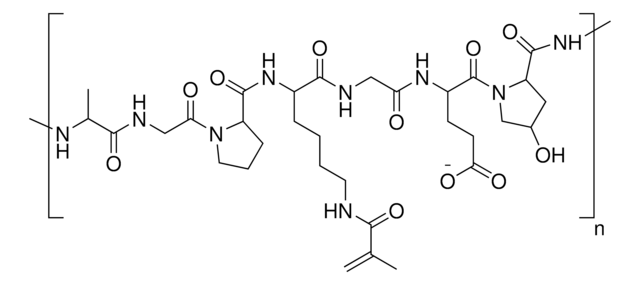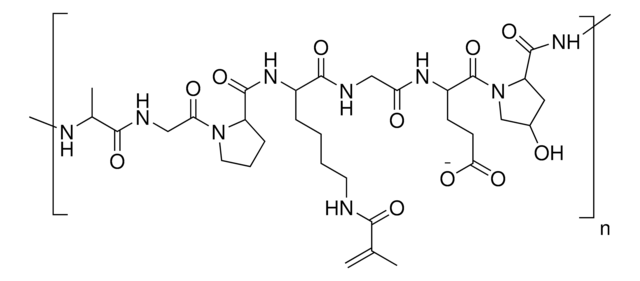925217
TissueFab® - low endotoxin GelMA-UV bioink
0.2 μm filtered, suitable for 3D bioprinting applications
Sinonimo/i:
Bioink, GelMA, Gelatin methacrylamide, Gelatin methacrylate, Gelatin methacryloyl
About This Item
Prodotti consigliati
Livello qualitativo
Sterilità
0.2 μm filtered
Stato
viscous liquid (to gel)
Misura
10 mL
Impurezze
≤5 CFU/g Bioburden
≤5 CFU/g Bioburden (Aerobic)
≤50 EU/mL Endotoxin
Colore
pale yellow to colorless
pH
6.5-7.5
Viscosità
2-20 cP
applicazioni
3D bioprinting
Temperatura di conservazione
2-8°C
Categorie correlate
Descrizione generale
The addition of photocrosslinkable methacrylamide functional groups in GelMA allows the synthesis of biocompatible, biodegradable, and non-immunogenic hydrogels that are stable in biologically relevant conditions and promote cell adhesion, spreading, and proliferation.
Temporal and spatial control of the crosslinking reaction can be obtained by adjusting the degree of functionalization and polymerization conditions, allowing for the fabrication of hydrogels with unique patterns, 3D structures, and morphologies.
Applicazioni
- osteogenic,
- chondrogenic ,
- hepatic ,
- adipogenic ,
- vasculogenic ,
- epithelial ,
- endothelial ,
- cardiac valve ,
- skin ,
- tumors
Caratteristiche e vantaggi
- Ready-to-use formulation optimized for high printing fidelity and cell viability, eliminating the lengthy bioink formulation development process
- Step-by-step protocols developed and tested by MilliporeSigma 3D Bioprinting Scientists, no prior 3D bioprinting experience neede
- Suitable for different extrusion-based 3D bioprinter model
- Methacrylamide functional group can also be used to control the hydrogel physical parameters such as pore size, degradation rate, and swell ratio.
Note legali
Codice della classe di stoccaggio
10 - Combustible liquids
Classe di pericolosità dell'acqua (WGK)
WGK 3
Scegli una delle versioni più recenti:
Certificati d'analisi (COA)
Ci dispiace, ma al momento non ci sono COA disponibili online per questo prodotto.
Se ti serve aiuto, non esitare a contattarci Servizio Clienti
Possiedi già questo prodotto?
I documenti relativi ai prodotti acquistati recentemente sono disponibili nell’Archivio dei documenti.
Il team dei nostri ricercatori vanta grande esperienza in tutte le aree della ricerca quali Life Science, scienza dei materiali, sintesi chimica, cromatografia, discipline analitiche, ecc..
Contatta l'Assistenza Tecnica.




